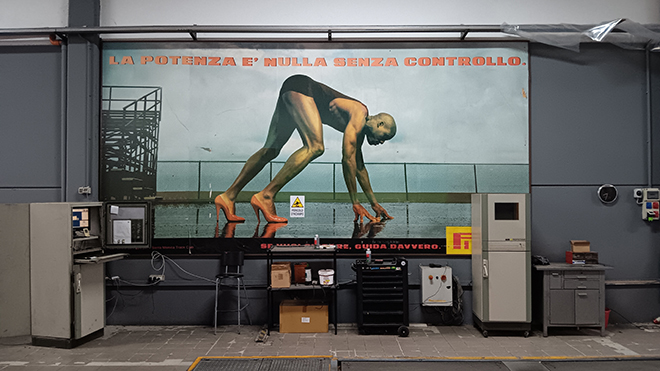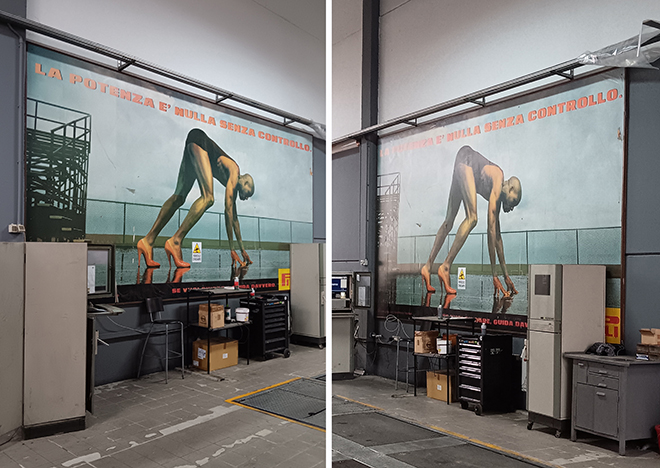Power is nothing without doubt

© arcomai I “Power is nothing without control”, Pirelli advertising campaign slogan (1994).
The 1990s were a decade of great social and cultural changes, and advertising was not immune to these transformations. A particularly interesting phenomenon of those years was the rise of provocative advertising, or shockvertising. This is a marketing strategy that aims to elicit a strong emotional reaction, often negative, in the public. The goal is to capture attention and get people talking about themselves, even at the cost of generating controversy. Several factors contributed to the spread of this type of advertising in that decade: advertising saturation, changing social values, and the birth of new media. With the increase in television channels and magazines, consumers were bombarded with advertising messages, and to navigate the market, companies had to find increasingly original and impactful solutions with messages characterized by greater openness towards issues such as sexuality, drugs, and violence. Advertising tried to ride this wave, often pushing the limits of good taste. The advent of the internet has offered new opportunities to spread advertising messages virally, and this has contributed to killing a way of doing advertising that sometimes produced real artistic masterpieces.
In recent times, due to overexposure to shocking content in the media and on social networks, the public has become more immune to this type of communication. This has led to a sort of habituation, whereby images that once would have caused a stir are now perceived as ordinary or even ignored. Moreover, this neo-culture of the media – which speaks a neo-language – can not only be refractory to advertising, which uses images or content of shockvertising, but even have negative reactions on public opinion, such as disgust, anger or fear. The values and sensitivities of the “social onlookers” are constantly evolving. What was once considered transgressive or provocative may now be perceived as banal or even harmful. In particular, in the woke culture, some people may find these messages offensive or inappropriate if they touch on sensitive issues such as violence, race, discrimination, or illness. Therefore, it is essential that brands take these changes into account and adapt their communication strategies accordingly at the expense of originality and creativity. To do this, it is necessary to move in some specific contexts, and invest resources in research on the target audience.
In Italy, two brands, although very different from each other, marked that era, building a reputation that today would be called “inclusive”: Pirelli and Benetton. In 1994, Carl Lewis, photographed in Texas by Annie Leibovitz in the classic pose of a sprinter about to start, wore a pair of red stiletto heels with the slogan “Power is nothing without control”. This is a message that has stood the test of time because it is relevant to the prerogatives of the product, the tire, but which at the same time could be used in different contexts, from sport to business, to emphasize the importance of self-control and one’s actions. But apart from the slogan, what caused a stir was seeing the greatest sprinter of those years wearing women’s shoes, a factor that fueled doubts about the sexual preferences – never confirmed, by the way – of the American champion. But 30 years later, those who saw that image only remember Lewis on stiletto heels rather than the promotional message linked to the product.
Doubt is the real product, to quote the well-known slogan “Doubt is our product” used by the tobacco industry in the second half of the 20th century. The phrase comes from a document made public only in 1969, but written in the 1950s, a secret memorandum entitled “Smoking and Health Proposal”, signed by Brown & Williamson, one of the largest tobacco corporations. The paper revealed many of the tactics employed by the industry to counter “anti-cigarette forces” according to a cynical strategy aimed at creating “public doubt” about the growing scientific evidence linking smoking to serious health problems such as cancer. By funding research that emphasized uncertainty and conflicting data, they aimed to confuse the public and delay regulations on tobacco products. In essence, they used doubt as a weapon to protect their profits, even at the cost of people’s health.
This document is a perfect example for scholars of “agnotology,” the discipline founded by science historian Robert Proctor, who thus renames his studies on ignorance. At the base is a thesis: “Ignorance is not only what we do not yet know, it is also a political plan, a deliberate creation by powerful agents who want you not to know.” One of the favorite means of manufacturers of ignorance is the so-called “balanced debate,” which in Italy was regulated by “par condicio”. To be clear, the idea that there should always be two opposing positions. This method does not always lead to a rational conclusion and is one of the main sources of the construction of ignorance, according to Proctor. Thus, doubt is the best means to compete with the “facts” that exist in the minds of the general public. And it is also the means to build a controversy. Just the opposite of what in Italy (between the ’70s and the late ’90s) did the “pubblicità progresso” (“public service advertising”) – of which today there is no trace – through communication campaigns dedicated to solving moral, civil and educational problems, and distributed for free.
The shockvertising approach of Benetton was more articulate and courageous, often using strong and controversial images to address social issues such as war, AIDS and racism. Oliviero Toscani (1942-2025), photographer and artistic director, collaborated with this well-known Italian clothing company, creating some of the most famous and discussed advertising campaigns of the ’90s that made history. His was an elegant, ironic, irreverent and sometimes naive – not to say poetic – (photographic0 message that played with oxymorons and commonplaces capable of always stimulating a proactive reflection on the public. A few weeks after his death, we can symbolically put a tombstone on a way of doing advertising that has contributed to emancipate a society, raising public awareness on important issues. When you saw those 6x3m posters on the street, you would have wanted to take them and hang them in your living room.

© arcomai I “Power is nothing without control”, Pirelli advertising campaign slogan (1994).
